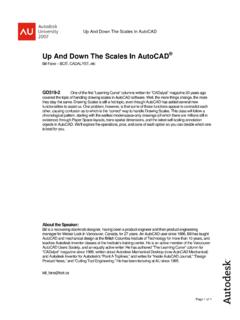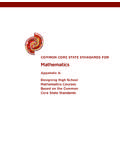Transcription of Blockbusters: Unleashing the Power of Dynamic …
1 blockbusters : Unleashing the Power of Dynamic Blocks Revealed! Matt Murphy - ACAD ventures GD201-3P Discover the full potential of Dynamic Blocks in AutoCAD. Learn how each parameter and action behaves and how these tools can be applied and implemented into your existing design processes. See over 20 examples of how Dynamic Blocks can be assembled from scratch to enhance and automate your office s design processes. Also featured are AutoLISP code examples that demonstrate how to manipulate Dynamic Block settings. About the Speaker: Matt has been recognized by Autodesk as a leader in providing professional training since 1985. He has served as an advisor and consultant to the training industry as chair of the Autodesk Training Center Advisory Board (ATCAB) and Executive Committee (ATCEC). Matt is also an Autodesk Approved Instructor (AAI) and a Certified Technical Trainer (CTT). He has received numerous instructional awards, including the ATC Eastern Regional Instructor of the Year for 2004.
2 A widely acclaimed top trainer and featured columnist for CADalyst and AUGIW orld magazines, he has presented at Autodesk University for 14 years and was the top Autodesk University speaker in a large session for 2006. blockbusters : Unleashing the Power of Dynamic Blocks Revealed! Introduction Blocks have been around since the very early days of AutoCAD. They were the first reusable content we created. Our ancestors of AutoCAD built thousands of them and stored them in read-only folders, and we share them for everyone to use. The three basic reasons for using them haven t changed: 1. They are easy to manipulate as they are unified. 2. They provide consistency for standards parts and details. 3. They reduce drawing file size as each block is a single data reference. In this session we ll look at how Dynamic Blocks are more flexible to manipulate than your existing traditional blocks. In this session we ll cover the following topics: 1.
3 An overview of different parameters and actions 2. Details on how each action of the block behaves and why 3. Specific scenarios of creating unique blocks 4. Troubleshooting common problems including chaining actions 5. Automating Dynamic Blocks with Fields and LISP I will also reveal many of the secrets that elude most users when creating and using Dynamic Blocks. What Are Dynamic Blocks? They are blocks that can have a variable appearance and placement using grip constraints. Dynamic Blocks are flexible and intelligent. They can automatically align themselves with existing geometry. They can have multiple insertion points. They can change visibility, representing multiple versions in one block instead of inserting multiple variations, and you can edit the geometry without exploding them. This enables you to modify the appearance of individual block references rather than searching for other block definitions to insert or redefining the existing ones.
4 Why Should I Use Dynamic Blocks? Blocks, an essential part of nearly any drawing, are used to represent real-world objects. Different variations of real-world objects can require you to define just as many variations of blocks. Dynamic Blocks will reduce your block library size. They can be locked and protected from being exploded. They can be placed on a Tool Palette for greater organization and they will make you more productive by maintaining standards and reducing your clicks and picks. Block References Are Easier to Use Introduced in AutoCAD 2006, Dynamic Block functionality enables you to edit the appearance of block instances without having to explode them. You can even manipulate a block instance during and after inserting it into a drawing. Traditional Blocks Multiple steps to place and align Design changes require erasing and reinserting or exploding, editing and redefining Dynamic Blocks Automatically align to nearby geometry Cycle between multiple insertion points 2 blockbusters : Unleashing the Power of Dynamic Blocks Revealed!
5 Change visibility of geometry to streamline design changes You can edit geometry within a block without exploding it As you move your cursor near drawing geometry, blocks will automatically align themselves with other objects. As you insert a Dynamic Block, you can cycle between key insertion points to find the one that makes the most sense for your current situation. The ability to cycle through insertion points can eliminate the need for you to move the block after it is inserted. Block definitions can contain multiple representations of a particular symbol. Upon insertion, you can choose which representation to use. For example, a single block definition could store multiple representations of a bed, faucet, door or valve. Understanding Dynamic Blocks Parameters control the actions of Dynamic Blocks. Parameters are special grips within Dynamic Blocks that enable you to move, scale, stretch and rotate, array and flip individual block geometry.
6 Parameters define the feature of the block that you can change. For example, you might have a bolt block, which you can stretch to a total length of between 1 and 4 units. As you stretch the bolt, the length is constrained to .5-unit increments and threads are automatically added or removed as you stretch the bolt. A second example might be a callout block that includes a circle, text and a leader line. You can rotate the leader around the circle while the text and circle remain static. A third example might be a door block. You can stretch the door width and flip the direction of the door swing. 3 blockbusters : Unleashing the Power of Dynamic Blocks Revealed! Working with Dynamic Blocks Dynamic Blocks will appear with a lightning bolt next to their preview before you insert them. When you insert a Dynamic Block, you can toggle through or cycle through the multiple insertion points with the CTRL key before you place it. Once you insert a Dynamic Block you can edit it using the Parameter control grip.
7 Now you can grip edit blocks the way we have grip edited other types of AutoCAD geometry. The shape of the grip determines the parameter type. How Do I Create Dynamic Blocks? The Block Editor enables you to create new block definitions or update your existing blocks. You can access the Block Editor from several locations and then use the block authoring tools to add parameters and actions to your block definition. Use the Block Editor The block editing environment is specifically designed for defining blocks. Make sure that the BLOCKEDITLOCK system variable is set to 0. You can access the Block Editor using any of the following methods: BEDIT command BE command alias Standard toolbar Tools menu Right-click menu with a block selected Block Definition dialog box 4 blockbusters : Unleashing the Power of Dynamic Blocks Revealed! Add Parameters and Actions to Block Definitions In the Block Editor, you can use typical AutoCAD drawing and editing functionality to create and modify the geometry for your block definition.
8 In addition, the Block Editor includes a toolbar and a block authoring palette, which enable you to apply parameters and actions to your block geometry. The block authoring palette includes three tabs. The first tab contains all of the available parameters. The second tab contains all of the available actions. And the third tab contains sets of the most commonly used combinations of parameters and actions. Parameters and actions work together to provide the editing capability of Dynamic Blocks. Parameters are dimensions that drive the block geometry. They are objects with their own relevant properties, which you can edit using the Properties window. For example, you can create a linear parameter to drive the width of a door and then apply properties that constrain the door width to 2-inch increments between the values of 18 and 36 inches. Actions are what change the geometry as you edit a block instance. For example, if you want to change the width of an inserted door block, you must apply a stretch action to the linear parameter that defines the door width.
9 Each parameter only works with specific types of actions, and a few parameters require no actions. We ll begin with the most basic parameters, the ones that don t require any actions: Alignment, Visibility and Base Point. These parameters are easy to create and they can dramatically increase the efficiency of your existing blocks with minimal effort. Alignment parameters require no actions although they can be included in the selection set of an action. You can add an alignment parameter to enable a block to align automatically to nearby geometry. If you create the alignment parameter at the origin point of the block, the alignment functionality will be available upon insertion. If you do not add an alignment parameter at the origin 5 blockbusters : Unleashing the Power of Dynamic Blocks Revealed! point, the alignment capability is available through cycling before you place it or after if you select the alignment grip on an inserted block.
10 For some blocks, you might find it useful to include multiple insertion points. For example, when inserting a stove block, you might want to insert it using the left corner, the right corner, or the center, depending on the other geometry in the drawing. You can define your blocks with multiple alignment parameters and then use the CTRL key to cycle between the alignment grips upon insertion. The parameter grips are actual objects in the Block Editor. If you don t want a grip to be included in the cycling options, you can select the grip in the Block Editor and then use the Properties window to turn off the Cycling option. If you want to change the location of the alignment grips, you can move the grip in the Block Editor. For example, if you want the stove to insert a slight distance away from the wall, you would create or move the alignment grip so that it is away from the stove geometry. In this example, changing the location of the left alignment grip means that it is no longer located at the origin point of the block.







